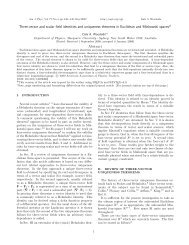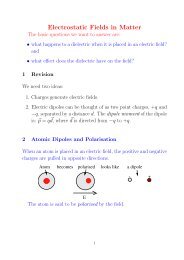<strong>Chapter</strong> 8 <strong>Vector</strong> <strong>Spaces</strong> <strong>in</strong> <strong>Quantum</strong> <strong>Mechanics</strong> 102which is a divergent series, i.e. this state cannot be normalized to unity. In contrast, ifc n = 1/n, n = 1, 2, . . ., then∞∑ 1〈ψ|ψ〉 =n = π2(8.75)2 6n=0which means we can normalize this state to unity by def<strong>in</strong><strong>in</strong>g√6| ˜ψ〉 = |ψ〉. (8.76)πThis shows that there are some l<strong>in</strong>ear comb<strong>in</strong>ation of states that do not represent possiblephysical states of the system. Such states do not belong to the Hilbert space H of thesystem, i.e. the Hilbert space consists only of those states for which the coefficients c nsatisfy Eq. (8.73) 2 . This is a new feature: the possibility of construct<strong>in</strong>g vectors that donot represent possible physical states of the system. It turns out that some very usefulbasis states have this apparently undesirable property, as we will now consider.8.6.2 Cont<strong>in</strong>uous Basis StatesIf we now turn to the example <strong>in</strong> the previous section of the <strong>in</strong>f<strong>in</strong>ite crystal, we can considerwhat happens if we suppose that the separation between the neighbour<strong>in</strong>g atoms <strong>in</strong>the crystal goes to zero, so that the electron can be found anywhere over a range extend<strong>in</strong>gfrom −∞ to ∞. This, <strong>in</strong> effect, is the cont<strong>in</strong>uous limit of the <strong>in</strong>f<strong>in</strong>ite crystal model justpresented, and represents the possible positions that a particle free to move anywhere <strong>in</strong>one dimension, the X axis say, can have. In this case, we could label the possible statesof the particle by its X position, i.e. |x〉, where now, <strong>in</strong>stead of hav<strong>in</strong>g the discrete valuesof the crystal model, the position can now assume any of a cont<strong>in</strong>uous range of values,−∞ < x < ∞. It would seem that we could then proceed <strong>in</strong> the same way as we havedone with the discrete states above, but it turns out that such states cannot be normalizedto unity and hence do not represent (except <strong>in</strong> an idealised sense) physically allowablestates of the system.The aim here is to try to develop a description of the possible basis states for a particlethat is not limited to be<strong>in</strong>g found only at discrete positions on the X axis. After all, <strong>in</strong>pr<strong>in</strong>ciple, we would expect that a particle <strong>in</strong> free space could be found at any position x <strong>in</strong>the range −∞ < x < ∞. We will get at this description by a limit<strong>in</strong>g procedure which isnot at all mathematically rigorous, but nevertheless yields results that turn out to be valid.2 Note however, that we can still construct a bra vectorn=∞ ∑〈ψ| = c ∗ n〈n|n=0without plac<strong>in</strong>g any restrictions on the convergence of the c n ’s such as the one <strong>in</strong> Eq. (8.73). The correspond<strong>in</strong>gket cannot then represent a possible state of the system, but such <strong>in</strong>ner products as 〈ψ|φ〉 where |φ〉is a normalized ket can still be evaluated. The po<strong>in</strong>t be<strong>in</strong>g made here is that if H is of <strong>in</strong>f<strong>in</strong>ite dimension,the dual space H ∗ can also <strong>in</strong>clude bra vectors that do not correspond to normalized ket vectors <strong>in</strong> H, whichemphasizes the fact that H ∗ is def<strong>in</strong>ed as a set of l<strong>in</strong>ear functionals, and not simply as a ‘complex conjugate’version of H. The dist<strong>in</strong>ction is important <strong>in</strong> some circumstances, but we will not have to deal with suchcases.
<strong>Chapter</strong> 8 <strong>Vector</strong> <strong>Spaces</strong> <strong>in</strong> <strong>Quantum</strong> <strong>Mechanics</strong> 103Suppose we return to the completeness relation for the states |na〉 for the one dimensionalcrystal|ψ〉 =+∞∑n=−∞|na〉〈na|ψ〉. (8.77)If we now put a = ∆x and na = x n , BUT we write |na〉 = √ a|x n 〉, this becomes|ψ〉 =+∞∑n=−∞|x n 〉〈x n |ψ〉∆x (8.78)where now〈x n |x m 〉 = δ nm(8.79)ai.e. each of the states |x n 〉 is not normalized to unity, but we can nevertheless identify sucha state as be<strong>in</strong>g that state for which the particle is at position x n – recall if a state vector ismultiplied by a constant, it still represents the same physical state of the system.If we put to one side any concerns about the mathematical legitimacy of what follows, wecan now take the limit ∆x → 0, i.e. a → 0, then Eq. (8.78) can be written as an <strong>in</strong>tegral,i.e.|ψ〉 =∫ +∞−∞|x〉〈x|ψ〉 dx (8.80)We can identify the state |x〉 with the physical state of affairs <strong>in</strong> which the particle is at theposition x, and the expression Eq. (8.80) is consistent with the completeness requirementi.e. that the states {|x〉, −∞ < x < ∞} form a complete set of basis states, so that any stateof the one particle system can be written as a superposition of the states |x〉, though thefact that the label x is cont<strong>in</strong>uous has forced us to write the completeness relation as an<strong>in</strong>tegral. The difficulty with this procedure is that the states |x〉 are no longer normalizedto unity. This we can see from Eq. (8.79) which tells us that 〈x|x ′ 〉 will vanish if x x ′ ,but for x = x ′ we see that1〈x|x〉 = lima→0 a = ∞ (8.81)i.e. the state |x〉 has <strong>in</strong>f<strong>in</strong>ite norm! This means that there is a price to pay for try<strong>in</strong>g to set upthe mathematics <strong>in</strong> such a manner as to produce the completeness expression Eq. (8.80),which is that we are forced to <strong>in</strong>troduce basis states which have <strong>in</strong>f<strong>in</strong>ite norm, and hencecannot represent a possible physical state of the particle! Nevertheless, provided care istaken, it is still possible to work with these states as if they represent the state <strong>in</strong> whichthe particle is at a def<strong>in</strong>ite position. To see this, we need to look at the orthonormalityproperties of these states, and <strong>in</strong> do<strong>in</strong>g so we are lead to <strong>in</strong>troduce a new k<strong>in</strong>d of function,the Dirac delta function.8.6.3 The Dirac Delta FunctionWe have just seen that the <strong>in</strong>ner product 〈x|x ′ 〉 vanishes if x x ′ , but appears to be <strong>in</strong>f<strong>in</strong>iteif x = x ′ . In order to give some mathematical sense to this result, we return to Eq. (8.80)and look more closely at the properties that 〈x|x ′ 〉 must have <strong>in</strong> order for the completenessrelation also to make sense.
















